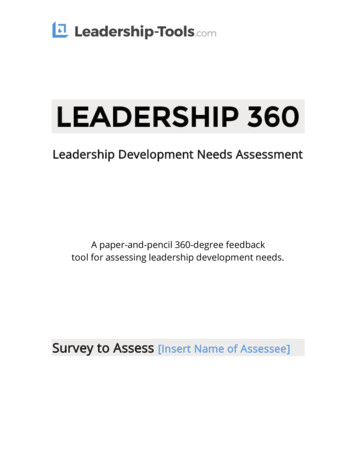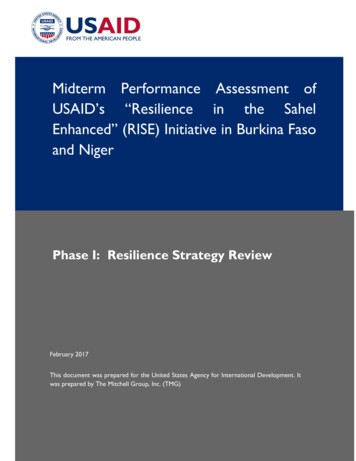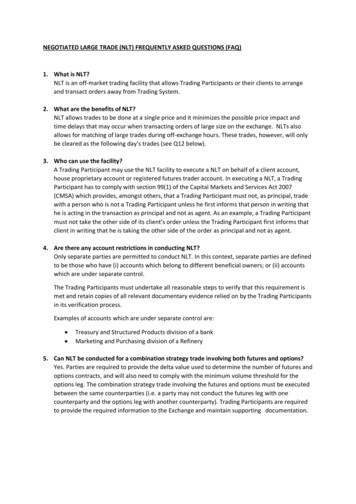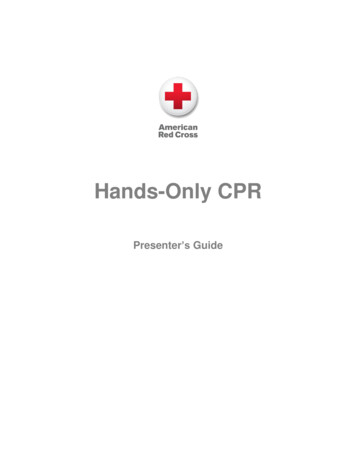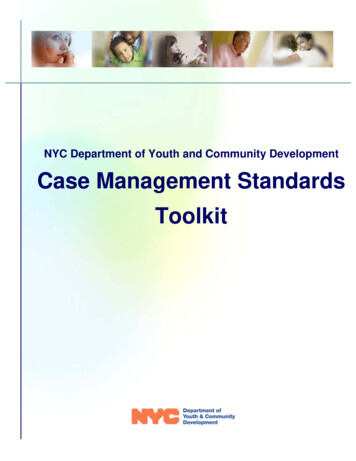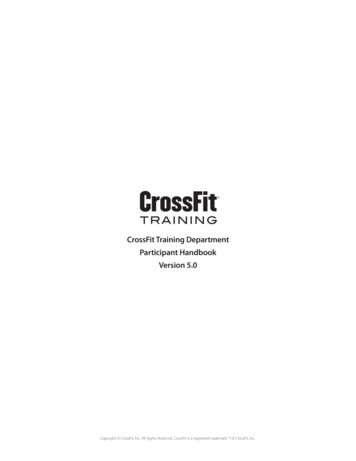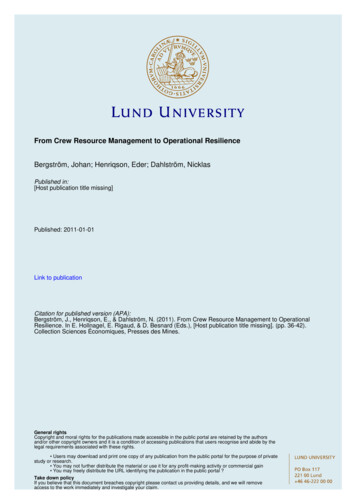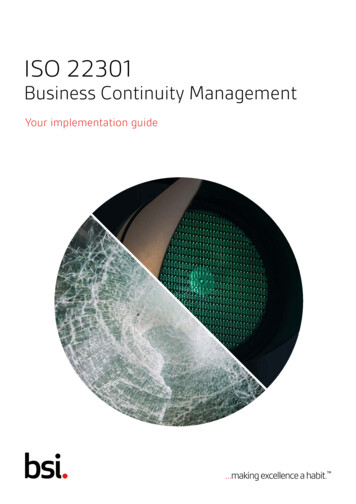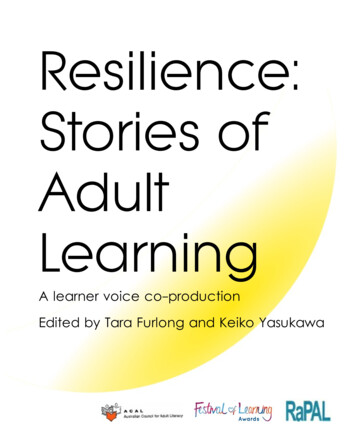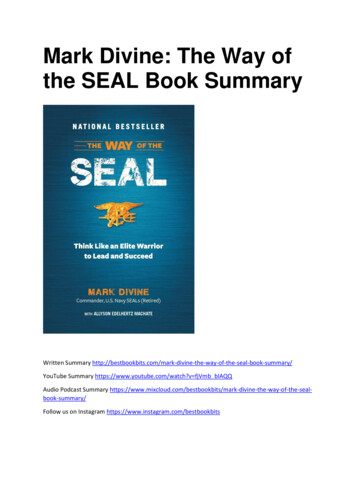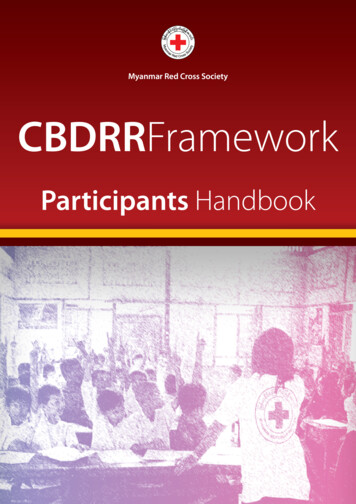
Transcription
Myanmar Red Cross SocietyCBDRRFrameworkParticipants Handbook
DisclaimerThe Community-based Disaster RiskReduction Participant Handbook isbased on the CBDRR Manual andis part of the CBDRR Frameworkof Myanmar Red Cross Society.Efforts have been made to ensurethe accuracy and reliability ofthe information contained inthis document. The documentremains open for correction andimprovement.Key ContributorsMRCSProf. Tha Hla ShwePresidentU Maung Maung KhinHead of Disaster Management DivisionRaphaelle GoepfertHead of DelegationShesh Kanta KafleDisaster Risk Reduction Program CoordinatorHerve GazeauDRR Regional Coordinator for South-East Asia and the PacificIFRCJohn HalderDisaster Management DelegateAmRCAdesh TripatheeRegional DRR AdvisorADPCAslam PerwaizHead of Department, DRMSThitiphon SinsupanProgram Manager, DRMSMareike BentfeldCBDRM Coordinator, DRMSFRC/CRC
Introduction to the TrainingThe ‘CBDRR Training Course’ is conducted by the Myanmar Red Cross Society withthe support of the various Partner National Societies. The course was designedat the end of 2013 as part of the project ‘Development of a Common CBDRRFramework for Myanmar Red Cross Society’. The CBDRR Training Course is basedon the CBDRR Step-by-Step Methodology and its main goal is to teach MRCS FieldStaff and MRCS RCVs to use the CBDRR Manual document which acts as a supportdocument for the implementation of CBDRR programs in Myanmar.The purpose of this ‘Participant Handbook’ is to help the course participants tofollow the CBDRR Training Course. The handbook contains all the information thatis needed by the participant to attend the training.In Part A, the course curriculum is presented and the participants can find a detailedschedule of their training. Furthermore, any additional information that is requiredby the participants such as accommodation during the training, the exact locationof the training etc. will be included in Part A.In Part B, each of the sessions will be discussed separately. Key questions thatparticipants should be able to answer after each session are posed and theparticipants are invited to note down their answer to each of the questions duringor after each session to increase the learning effect.In Part C, the supporting training documents will be presented. You can find a listwith all participants and their contact details as well as a list of the facilitators inthere.
2CBDRRFRAMEWORKPartABasic InformationCourse CurriculumThe course curriculum consists of 2 core modules (Module 2-3) which cover all theinformation included in the CBDRR Manual as well as two optional modules. Module 1 isan introductory module which is conducted during the standard CBDRR Training. Module4 is only conducted during Training of Trainers. In the next paragraph, all 4 Modules areshortly presented.Module 1: Understanding the BasicsModule 1 introduces the participants to the basics of CBDRR implementation of MRCS.Module 1 includes a short introduction to the CBDRR Manual to familiarize the participantswith the document. Furthermore, general aspects of CBDRR in the context of Myanmarare discussed to ensure that all participants have the same knowledge level.Module 2: Implementing the ProgramModule 2 introduces the participants to the 9 CBDRR steps that are followed by MRCSwhen implementing community- and school-based programs. The key points for eachof the steps are discussed and participants will be trained to use the CBDRR Manual asreference in future program implementation.Module 3: Ensuring SustainabilityModule 3 introduces the participants to two aspects that are often forgotten when itcomes to program implementation. One session will deal with the development andimplementation of an exit strategy, and another session will introduce the participants indetail to the process of impact measurement.Module 4: Being a FacilitatorModule 4 is an optional module which will only be administered during a ToT. The moduleintroduces the participants to facilitation skills and some exercises are carried out that willhelp the participants to be a facilitator of the course themselves in the end.
Participants HandbookDay 1 CBDRR TrainingTimeActivityResponsible PersonInauguration Session08:30 – 09:00Registration09:00 – 10:30Welcome Speech10:30 – 10:45Coffee break10:45 – 12:30Training Introduction12:30 – 13:30Lunch breakModule 1: Understanding the Basics13:30 – 14:15Module 1 Session 114:15 – 15:15Module 1 Session 215:15 – 15:30Coffee break15:30 – 17:00Module 1 Session 3Day 2 CBDRR TrainingTimeActivityResponsible PersonModule 2: Implementing the Program9:00 – 10:30Module 2 Session 110:30 – 10:45Coffee break10:45 – 12:30Module 2 Session 212:30 – 13:30Lunch break13:30 – 13:45Module 2 Session 315:00 – 15:15Coffee break15:15 – 17:00Module 2 Session 3 cont’dDay 3 CBDRR TrainingTimeActivityModule 2: Implementing the Program9:00 – 10:30Module 2 Session 410:30 – 10:45Coffee break10:45 – 12:30Module 2 Session 4 cont’d12:30 – 13:30Lunch break13:30 – 15:00Module 2 Session 515:00 – 15:15Coffee break15:15 – 17:00Module 2 Session 6Responsible Person3
4CBDRRFRAMEWORKDay 4 CBDRR TrainingTimeActivityResponsible PersonModule 3: Ensuring Sustainability9:00 – 10:30Module 3 Session 110:30 – 10:45Coffee break10:45 – 12:30Module 3 Session 212:30 – 13:30Lunch breakModule 4: Simulation Exercise13:30 – 15:00Wrap up and Award CeremonyDay 1 ToT CBDRR TrainingTimeActivityResponsible PersonInauguration Session08:30 – 09:00Registration09:00 – 10:30Welcome Speech10:30 – 10:45Coffee break10:45 – 11:30Training Introduction11:30 – 12:30Module 1 Session 112:30 – 13:30Lunch breakModule 2: Implementing the Program13:30 – 15:15Module 2 Session 115:15 – 15:30Coffee break15:30 – 17:00Module 2 Session 2Day 2 ToT CBDRR TrainingTimeActivityModule 2: Implementing the Program9:00 – 10:30Module 2 Session 310:30 – 10:45Coffee break10:45 – 12:30Module 2 Session 3 cont’d12:30 – 13:30Lunch break13:30 – 13:45Module 2 Session 415:00 – 15:15Coffee break15:15 – 17:00Module 2 Session 4 cont’dResponsible Person
Participants HandbookDay 3 ToT CBDRR TrainingTimeActivityResponsible PersonModule 2: Implementing the Program9:00 – 10:30Module 2 Session 510:30 – 10:45Coffee break10:45 – 12:30Module 2 Session 612:30 – 13:30Lunch breakModule 3: Ensuring Sustainability13:30 – 15:00Module 3 Session 115:00 – 15:15Coffee break15:15 – 17:00Module 3 Session 2Day 4 ToT CBDRR TrainingTimeActivityModule 4: Being a Facilitator9:00 – 10:30Module 4 Session 110:30 – 10:45Coffee break10:45 – 12:30Module 4 Session 212:30 – 13:30Lunch breakClosing Ceremony13:30 – 15:00Feedback Session15:00 – 15:15Coffee break15:15 – 17:00Wrap up and Award CeremonyResponsible Person5
6CBDRRFRAMEWORKTraining Location and Provisions
Participants Handbook7Key Learning Points from eachSessionPartBModule 1: Understanding the BasicsDescriptionModule 1 introduces the participants to the basics of CBDRR implementation of MRCS. Themodule includes a short introduction to the CBDRR Manual to familiarize the participantswith the document. Furthermore, general aspects of CBDRR in the context of Myanmarare discussed to ensure that all participants have the same knowledge level.Learning ObjectivesAt the end of this module, the participants will be able to Explain basic terms and concepts related to community based disaster risk reduction(CBDRR); Explain the essential elements and benefits of CBDRR as well as its fundamentalprocess; Understand why CBDRR is relevant for Myanmar; Examine challenges and opportunities in Myanmar with regards to advocating forwide-spread adoption of CBDRR.Learning SessionsThe following topics will be covered in Module 1:Session 1 – Introduction to the CBDRR ManualSession 2 – CBDRR in MyanmarSession 3 – Key Concepts and Terminology
8CBDRRFRAMEWORKSession 1.1 Introduction to the CBDRR ManualQuestion 1: What is the main objective of the CBDRR Manual?Question 2: What kind of information will you find when you see this icon in the CBDRR Manual?Question 3: Which chapter would you read when you need additional information about conducting the baselinestudy?
Participants HandbookQuestion 4: In which situation will the CBDRR Manual be useful to you?New Learning and Reflections9
10CBDRRFRAMEWORKSession 1.2 CBDRR in MyanmarQuestion 1: What are the 8 key elements of CBDRR?1.2.3.4.5.6.7.8.Question 2: Why is CBDRR relevant for Myanmar?Question 3: Describe one challenge faced when implementing CBDRR in Myanmar.
Participants HandbookNew Learning and Reflections11
12CBDRRFRAMEWORKSession 1.3 Key Concepts & TerminologyQuestion 1: What is the difference between the terms response and recovery?Question 2: What is the difference between preparedness and prevention?
Participants HandbookQuestion 3: Please mark vulnerabilities, hazards, capacities and risk in the map underneath.13
14CBDRRFRAMEWORKNew Learning and Reflections
Participants Handbook15Module 2: Implementing the ProgramDescriptionModule 2 introduces the participants to the 9 CBDRR steps that are followed by MRCSwhen implementing community- and school-based programs. The key points for each ofthe steps are discussed and the participants will be trained to use the CBDRR Manual asreference in future program implementation.Learning ObjectivesAt the end of this module, the participants will be able to Understand the process of selecting the target community using suitable criteria atdifferent levels: state/region, township and village/ village tract/ ward. Describe the socialization process that follows the target community selection. Mobilize the community by organizing them into functional entity like VDMCs andSDMCs. Identify capacity building needs of the newly formed community level DMCs anddesign and deliver the appropriate training activities. Undertake developing and conducting of Multi-Sector Assessment exercise todetermine the community disaster risk reduction needs. Oversee the development of community and school action plans based on the resultsof the Multi-Sector Assessment and employing participatory planning approach informulating the essential risk reduction measures.Learning SessionsThe following topics will be covered in Module 2:Session 1 – Program SocializationSession 2 – Program Site SelectionSession 3 – Mobilizing the Community and the RCVsSession 4 – Identification of Community NeedsSession 5 – Participatory Community Action PlanningSession 6 – Implementation of Action Plans
16CBDRRFRAMEWORKSession 2.1 Program SocializationQuestion 1: What are the key benefits of conducting socialization meetings at all levels?Question 2: What kind of information should be shared at township level?Question 3: Are there differences between the socialization meetings at the different levels when it comes to thekey goal of these meetings?
Participants HandbookNew Learning and Reflections17
18CBDRRFRAMEWORKSession 2.2 Program Site SelectionQuestion 1: Choose one of the selection criteria for township selection and explain why this criterion is important.Question 2: How can be ensured that the selection process is as fair as possible?Question 3: Why is it important to conduct socialization meetings at all levels?
Participants HandbookNew Learning and Reflections19
20CBDRRFRAMEWORKSession 2.3 Mobilizing the Community and the RCVsQuestion 1: What is community mobilization and why is it important?Group Discussion1. Based on your experience from the field what are the two most important characteristics of a DMC?2. What kind of training is most important to ensure a functional DMC?
Participants Handbook3. What challenges do you face in organizing the trainings, and what are the solutions?New Learning and Reflections21
22CBDRRFRAMEWORKSession 2.4 Identification of Community NeedsQuestion 1: What are the characteristics of a Multi-Sector Assessment?Question 2: Which assessment tool did you already use in the field? Briefly describe your experience with thatassessment tool.Exercise – ‘Getting everybody’s views’1. Pick one of the stakeholder cards and read the information.2. What kind of information can be collected from this person?a.b.
Participants Handbookc.3. How do I make sure that this person is engaged in the MSA process?New Learning and Reflections23
24CBDRRFRAMEWORKSession 2.5 Participatory Community Action PlanningQuestion 1: Who should be involved in making the community action plan?Question 2: What should be kept in mind when formulation the risk reduction measures?Question 3: What are possible challenges that could be faced when formulating the community action plan?
Participants HandbookNew Learning and Reflections25
26CBDRRFRAMEWORKSession 2.6 Implementation of Action PlansQuestion 1: Write done two of the guiding principles for participatory implementation process and explain whythey are important.1.2Question 2: What kind of skills does the VDMC need in order to implement the community action plan?Question 3: How can it be assured that all vulnerable groups in the community are given a chance to participate orhave a say in the implementation process?
Participants Handbook27Question 4: Please discuss and explain briefly different monitoring and evaluation functions involved in theimplementation of a CBDRR program.New Learning and Reflections
28CBDRRFRAMEWORKModule 3: Ensuring SustainabilityDescriptionModule 3 introduces the participants to two aspects that are often forgotten when itcomes to program implementation. One session will deal with the development andimplementation of an exit strategy, and another session will introduce the participants indetail to the process of impact measurement.Learning ObjectivesAt the end of this module, the participants will be able to Understand the process of selecting the target community using suitable criteria atdifferent levels: state/region, township and village/ village tract/ ward. Describe the socialization process that follows the target community selection. Mobilize the community by organizing them into functional entity like VDMCs andSDMCs. Identify capacity building needs of the newly formed community level DMCs anddesign and deliver the appropriate training activities. Undertake developing and conducting of Multi-Sector Assessment exercise todetermine the community disaster risk reduction needs. Oversee the development of community and school action plans based on the resultsof the Multi-Sector Assessment and employing participatory planning approach informulating the essential risk reduction measures.Learning SessionsThe following topics will be covered in Module 3:Session 1 – Measuring the ImpactSession 2 – Empowerment of the Community
Participants Handbook29Session 3.1 Measuring the ImpactQuestion 1: What are the differences and similarities between baseline and end-line studies?Question 2: Who should be effectively involved in those studies (consider both the data collectors as well as therespondents)?
30CBDRRFRAMEWORKQuestion 3: Do you have an experience in conducting baseline or end-line study or both? If so, what kind ofchallenges have you encountered and how did you overcome them?New Learning and Reflections
Participants HandbookSession 3.2 Empowerment of the CommunityQuestion 1: Why is it important to have an exit strategy in place?Question 2: When is the best time to develop an exit strategy and why?31
32CBDRRFRAMEWORKQuestion 3: How can we ensure the local partners are adequately equipped with necessary capacities, skills andinformation to continue with the DRR initiatives?New Learning and Reflections
Participants Handbook33Module 4: Being a FacilitatorDescriptionModule 4 is an optional module which will only be administered during a ToT. The moduleintroduces the participants to facilitation skills and some exercises are carried out that willhelp the participants to be a facilitator of the course themselves in the future.Learning ObjectivesAt the end of this module, the participants will be able to use various methods of instructional communication make presentations as an individual and as a member of a team make use of the CBDRR Facilitators GuidebookLearning SessionsThe following topics will be covered in Module 5:Session 1 – Key Facilitation Skills
34CBDRRFRAMEWORKSession 4.1 Key Facilitation SkillsQuestion 1: What do the 6 P’s stand for?1. P2. P3. P4. P5. P6. PQuestion 2: What are common communication barriers?
Participants HandbookNew Learning and Reflections35
36CBDRRFRAMEWORKPartCSupporting DocumentsList of participants
Participants HandbookList of Trainers37
The Community-Based Disaster Risk Reduction Framework is an initiative led by the Myanmar Red Cross Society withthe support of the International Federation of Red Cross/Red Crescent Societies, the French Red Cross, the CanadianRed Cross and the American Red Cross to harmonize and consolidate existing CBDRR methodologies, procedures, andpractices of Myanmar Red Cross Society. The CBDRR Framework entails 5 different outputs.1. CBDRR Practice Case Studies: Five CBDRR Practice Case Studies have been developed under the CBDRR Framework sofar showcasing a range of activities undertaken by MRCS to implement CBDRR projects. The topics of the CBDRR PracticeCase Studies are project site selection, township capacity building, baseline studies, community mobilization andawareness raising in communities. These Practice Case Studies reflects the status quo, highlighting commonalities butalso points out the different approaches, methodologies and tools used by MRCS in their project implementation.2. CBDRR Step-by-Step Methodology: The CBDRR Step-by-Step Methodology is a consolidation and harmonizationof existing CBDRR methodologies, procedures, and practices of Myanmar Red Cross Society. It aims to guide thedevelopment and effective implementation of new community-based as well as school-based interventionsimplemented by the Myanmar Red Cross Society as well as other DRR actors in Myanmar by identifying key steps thatform the basis of each CBDRR program.3. CBDRR Manual: The CBDRR Manual is a practical how-to-guide for Red Cross Volunteers trained in CBDRR, MRCSprogram staff as well as any other CBDRR Practitioners in Myanmar. Together with the CBDRR Awareness Tool Box, theCBDRR Manual provides guidance and support to the implementation of community-based programs in Myanmar byexplaining each of the implementation steps as well as the tools used. It is based on the Minimum Activities that havebeen identified in the CBDRR Step-by-Step Methodology.4. CBDRR Training Modules: The CBDRR Training Modules are based on the common CBDRR implementation approachas defined in the CBDRR Manual and will teach Red Cross Volunteers, MRCS program staff as well as any other CBDRRPractitioners in Myanmar how to implement CBDRR programs with the common approach as well as how to use theCBDRR Manual in a field setting. The CBDRR Training Modules include PowerPoint presentations as well as a facilitatorguidebook and a participant’s handbook.5. CBDRR Awareness Tool Box: The CBDRR Awareness Tool Box includes all the tools that are currently used in CBDRRprograms to raise awareness. The CBDRR Awareness Tool Box provides an overview about all the existing tools andprovides guidance about the use of the tools in CBDRR programs.For more information, please contact;Head of Disaster Management DivisionMyanmar Red Cross Society (MRCS)Raza Thingaha Road, Dekhinatihiri, Nay Pyi Taw, MyanmarTel ( 95) 067-419017 Ext. 220Fax ( 95) 067-419017 Ext. 221Email dm1@myanmarredcross.org.mmThe CBDRR Framework initiative is supported byCBDRR Framework facilitated by
Reduction Participant Handbook is based on the CBDRR Manual and is part of the CBDRR Framework of Myanmar Red Cross Society. Efforts have been made to ensure the accuracy and reliability of the information contained in this document. The document remains open for correction and improv
